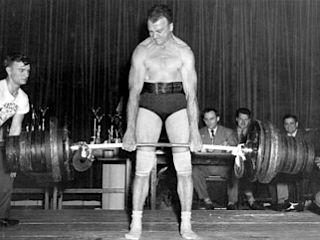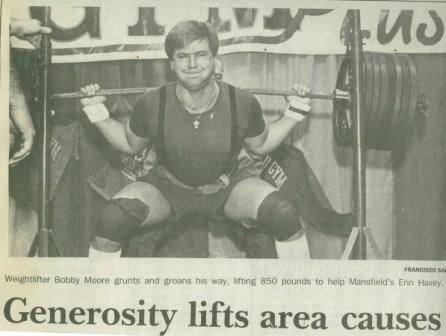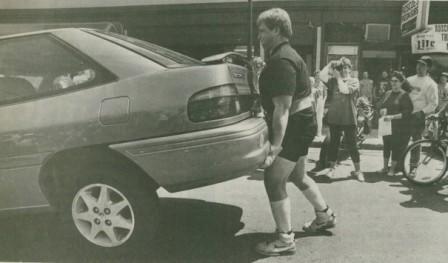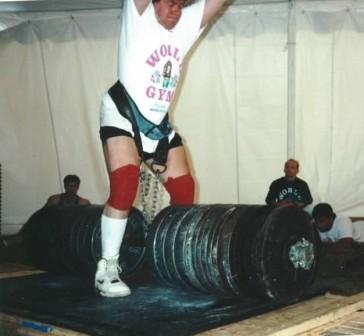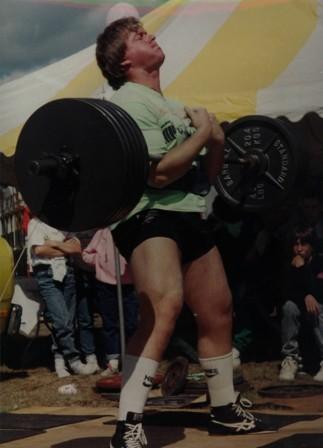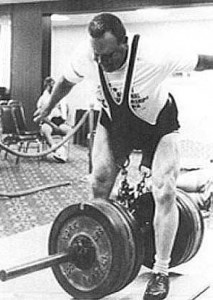Mr. Deadlift – John Robert Peoples
by Dennis Mitchell
Bob Peoples was born Aug. 2nd, 1910 in Northern Tennessee. He stated that no one in particular started him lifting, and that he always admired men who were strong and that his father was locally noted for his strength. He started lifting his father’s 50 pound dumbbell and anything else that would give him a challenge. He lived on a farm and trained outside or in one of the out buildings. Eventually he moved to his own house and had a gym in his basement that was referred to as “The Dungeon”. Other than lifting, Bob’s favorite sport was horse back riding and he spent many hours riding the mountain trails.
Bob was quite strong and was never a 97 pound weakling. When he started lifting he could deadlift 350 pounds and clean and jerk 160 pounds. At first he followed no set system of training as he was unaware that there were actual training systems. Later he followed the advice given in the different lifting magazines.
Much of his equipment was home made, although he did have a Milo Duplex Barbell set. He would use 50 gallon drums that he would fill with rocks. Later he added a Jackson International Olympic set with plenty of extra plates. He was unhappy with his progress in the Olympic lifts. As a middle weight in 1937 he did a 150 pound press, a 160 pound snatch and a 205 pound clean and jerk. It was at this time he started to experiment with different training ideas and is credited with making the first power rack.
Bob’s most outstanding lift was the deadlift, and in 1940 after winning the Tennessee State Olympic Lifting meet he made an official deadlift of 600 pounds, which was a “Southern” record.
Bob’s progress was interrupted by some health problems and during the war years the demands on farmers limited his training. However by the time of the Tennessee State championships in 1946, Bob was doing quite well and won the light heavy weight division with a deadlift of 651.25 pounds at a bodyweight of 175 pounds, which was a world record, beating Jack Hope’s record of 624.25 pounds. Later that same year at a show put on by Bob Hise, Bob lifted 700 pounds, only to find out when the bar was weighed it was 699 pounds. The newspaper photographer missed photographing the lift so Bob did it again so he could get the photograph. Later that year he did break the 700 pound barrier with a lift of 710 pounds. He did not get official credit for this lift as it was not weighed, as was the rules at that time.
Bob’s top deadlift was 728 pounds at a body weight of 178 pounds. He did all his lifts with an overhand grip, and of course at that time there were no power suits.
Other outstanding lifts that he made included deadlifting 500 pounds 20 times, a deadlift off of high blocks of 900 pounds, a 530 pound full squat, a 300 pound bench press, alternate standing press with a pair of 130 pound dumbbells, and cleaning a pair of 110 pound dumbbells for 10 reps.
He is in the U. S. Power lifting Hall of Fame, the Tennessee Sports Hall of Fame, and the Upper East Tennessee Sports Hall of Fame. He was also very active in local civic and political issues.
Bob was married for 53 years to Junta Wills People. They had one daughter. Two grand daughters and one great grand daughter. Bob passed away in 1992.
